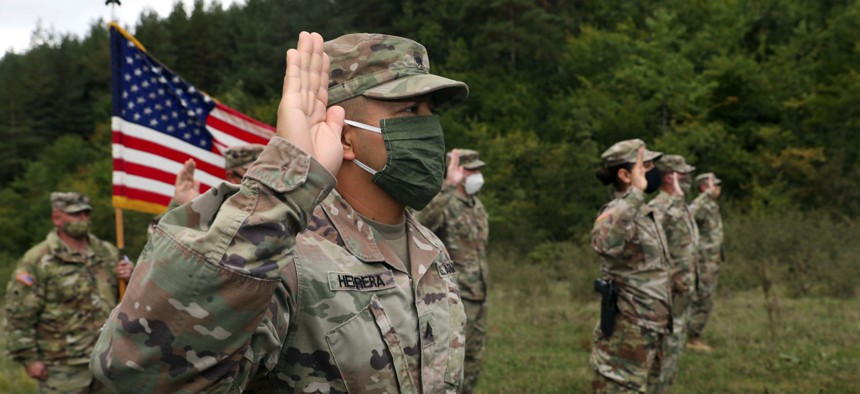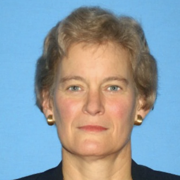
Soldiers from the U.S. Army National Guard and U.S. Army Reserve participate in a reenlistment ceremony Sept. 26, 2020, near Ferizaj/Urosevac, Kosovo. U.S. Army National Guard / Spc. Miguel Ruiz
How to Teach Troops about the Constitution
We can’t assume they know enough about what they’re swearing to support and defend.
As a veteran, I was mortified by the large number of U.S. military veterans involved in the Jan. 6 riot at the Capitol. The Joint Chiefs of Staff reacted by reminding service members to abide by their oaths of office — and yet one of the many things the insurrection revealed is that some troops might not understand their sworn duty to “support and defend the Constitution of the United States.”
This realization invalidates the longstanding assumption that servicemembers have acquired an understanding of the U.S. Constitution in their high school civics classes, and as one veteran argued recently, suggests that the military needs to fill this crucial educational gap. How might it go about doing so?
First, on the day new servicemembers are sworn in, they should receive their own copies of the U.S. Constitution and the Declaration of Independence. Symbolism and pageantry should mark this moment. And recruits should understand they should keep this copy close throughout their career.
Second, new members of the military should memorize the oath of office and the preamble to the Constitution during the early days of their training. This means those in uniform are always “carrying” their oath and a portion of the Constitution with them, regardless of where they might be stationed, or the task at hand.
Third, starting with basic training, all services should set aside time to teach the basics of the U.S. government, the Constitution, and the oath of office. This must be interactive, not a lecture. After years of discussing these in my American Defense Policy course, I remain amazed at how dynamic the discussion is about the U.S. Constitution, in particular. All recruits deserve a similar experience. In the process, trainers and trainees alike would learn much, and the Constitution and oath of office would assume a vibrancy and relevance they might otherwise lack.
Fourth, the service chiefs should ask their unit commanders to hold sessions at regular intervals to discuss the Constitution and oath. Commanders should participate in, but not dominate, such events. These occasions could involve someone from the unit, a guest speaker (e.g., a local high school or college educator), a movie or podcast followed by a discussion session. The key is to engage all servicemembers and reinforce the importance of their oaths.
Fifth, every level of officer and enlisted professional military education, or PME, should integrate the Constitution and the oath of office into its curriculum. PME offers the best opportunity to delve into the substance of both. It also allows servicemembers the chance to examine the expectations associated with the oath more closely, along with possible issues and controversies. Any PME curriculum that tries to take on issues of professionalism, warfighting, strategy or policy, without discussing them in terms of the larger national obligations associated with service, is a failure.
Finally, every servicemember’s copy of the Constitution should include a signature page. Whenever someone reaffirms their oath during a promotion ceremony (which should be mandatory for every rank), they should ask the person administering it to sign and date that page. While the ceremony might be creative (e.g., underwater, in space), its core purpose is profoundly solemn. By asking the person administering the oath to help commemorate the event, an important link is forged from one professional generation to the next.
Some of the arguments against the above are easy to imagine: these ideas underestimate what servicemembers know about the Constitution; all of this takes away from valuable training time; these tasks levy yet another demand on already overburdened servicemembers. The list goes on and invariably some modicum of truth resides in each argument. Soldiers, sailors, Marines, airmen, and guardians are well educated. They do need to learn their services’ heritage, focus on mastering their specialties, and learn how to contribute to their units. This is all true. But we cannot forget that the Jan. 6 insurrection compelled the JCS to tell servicemembers to abide by their oath, and the law. That stunning memo demands immediate corrective action throughout the military.
The military cannot, and should not, educate every citizen; but it must educate those in its ranks. They deserve to understand the larger context for their service. Whatever military organization they join, it is only a piece of the larger U.S. military that provides “for the Common Defense.” By integrating discussions about the U.S. Constitution and the oath of office into all aspects of military training and education, the military creates better servicemembers — and better citizens.
Paula G. Thornhill is a retired U.S. Air Force brigadier general; acting director of Strategic Studies, Johns Hopkins University (SAIS); and author of Demystifying the American Military.
